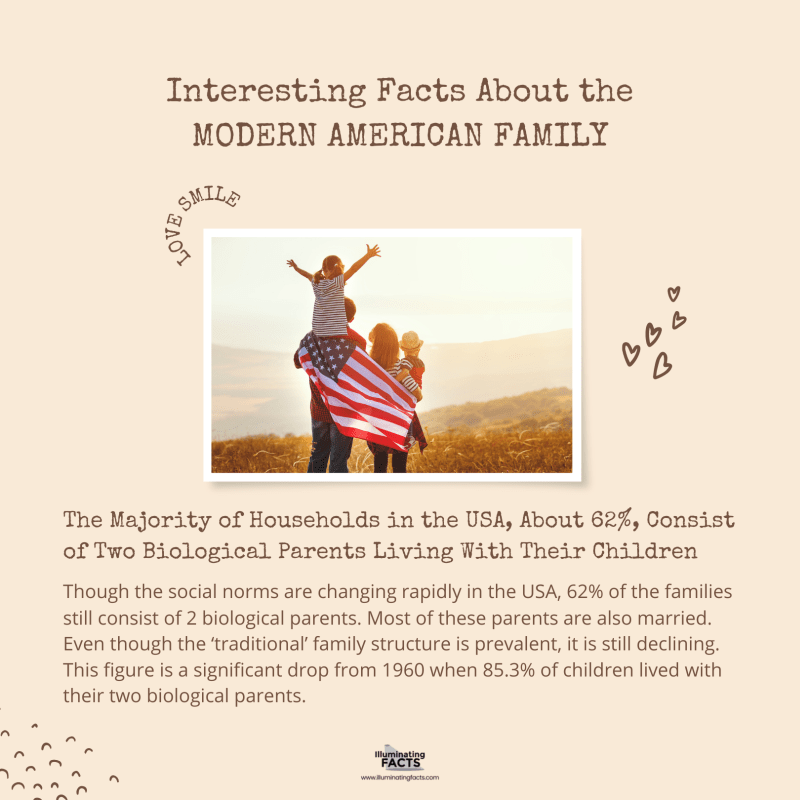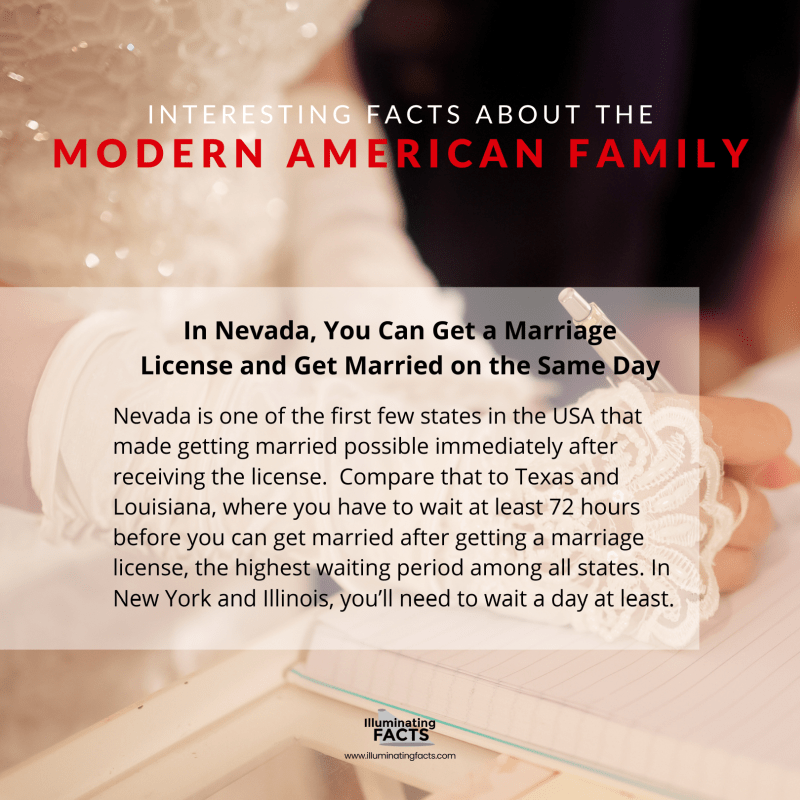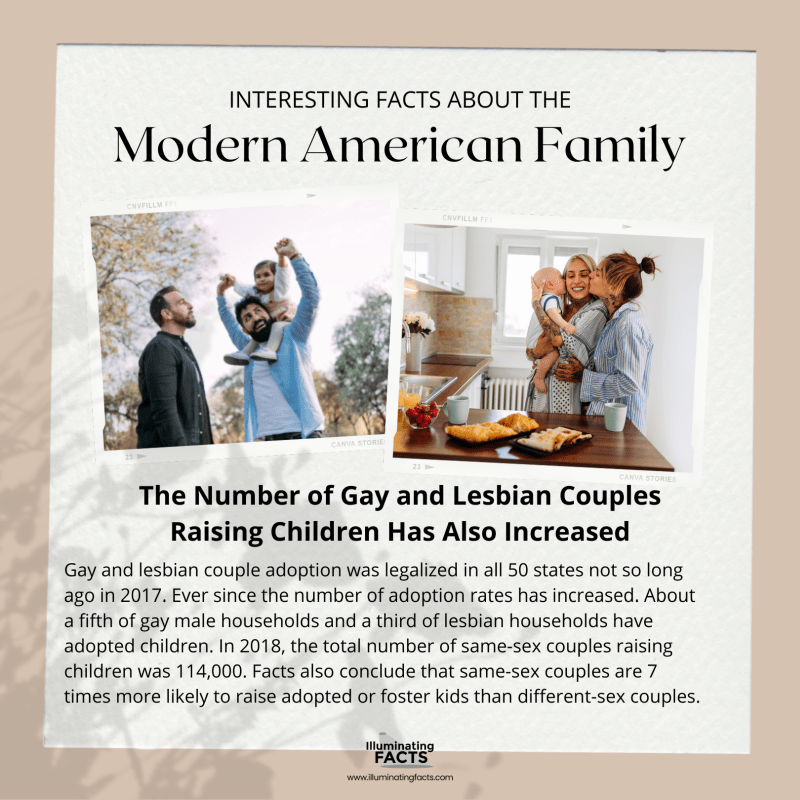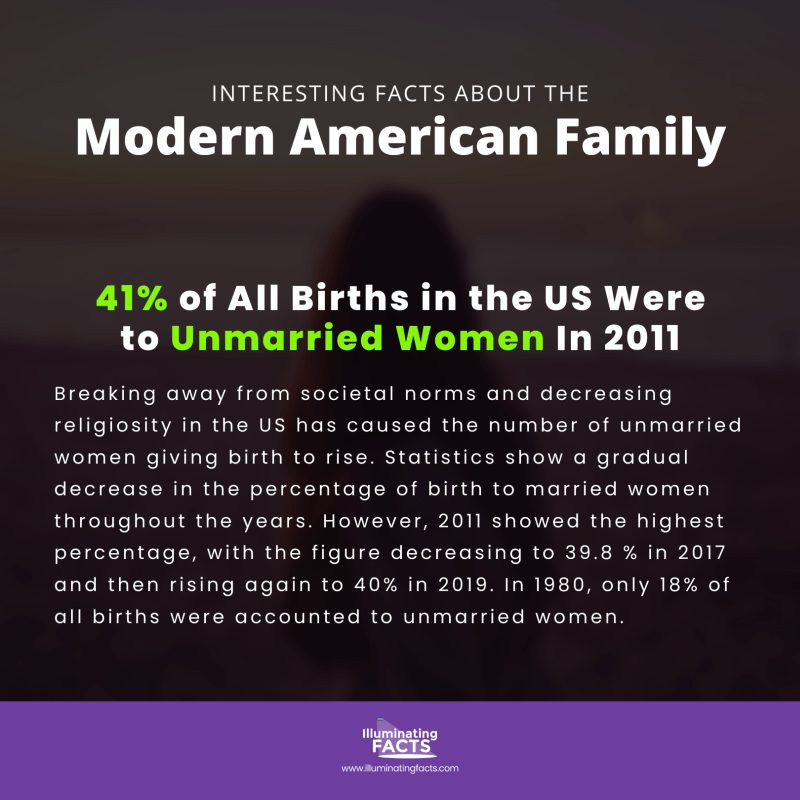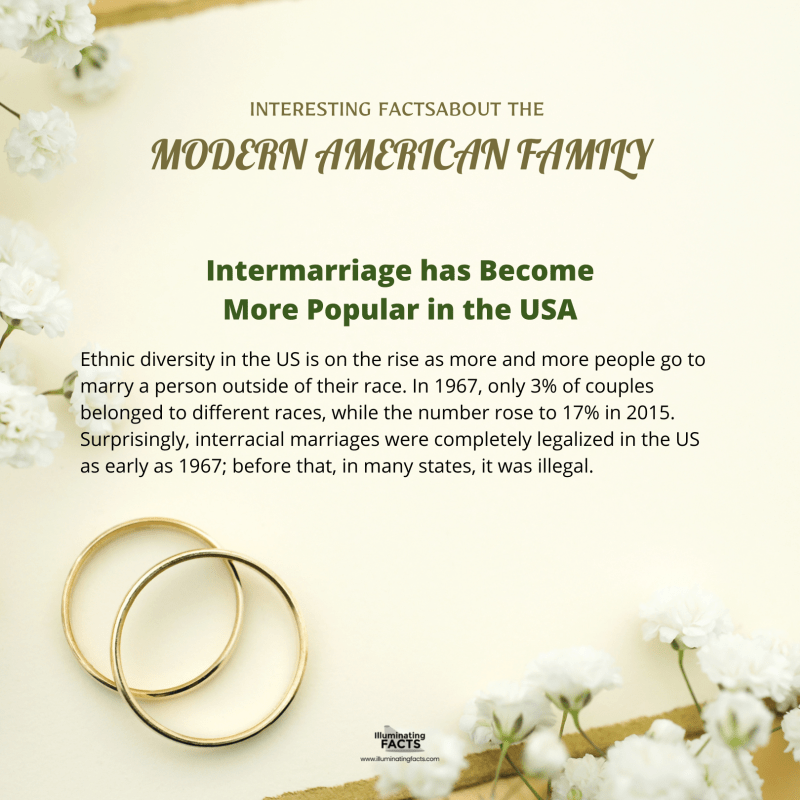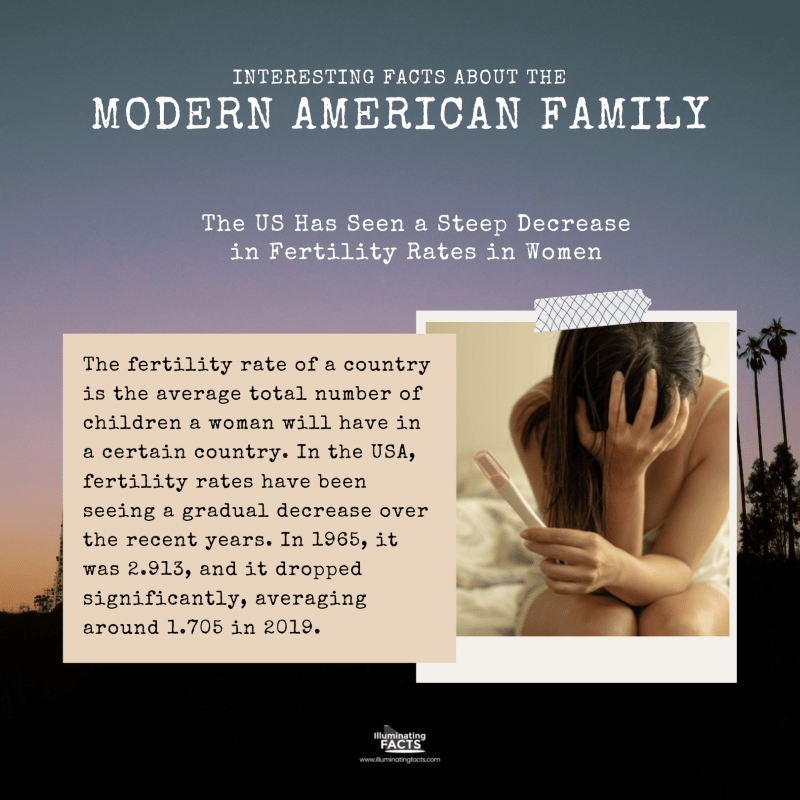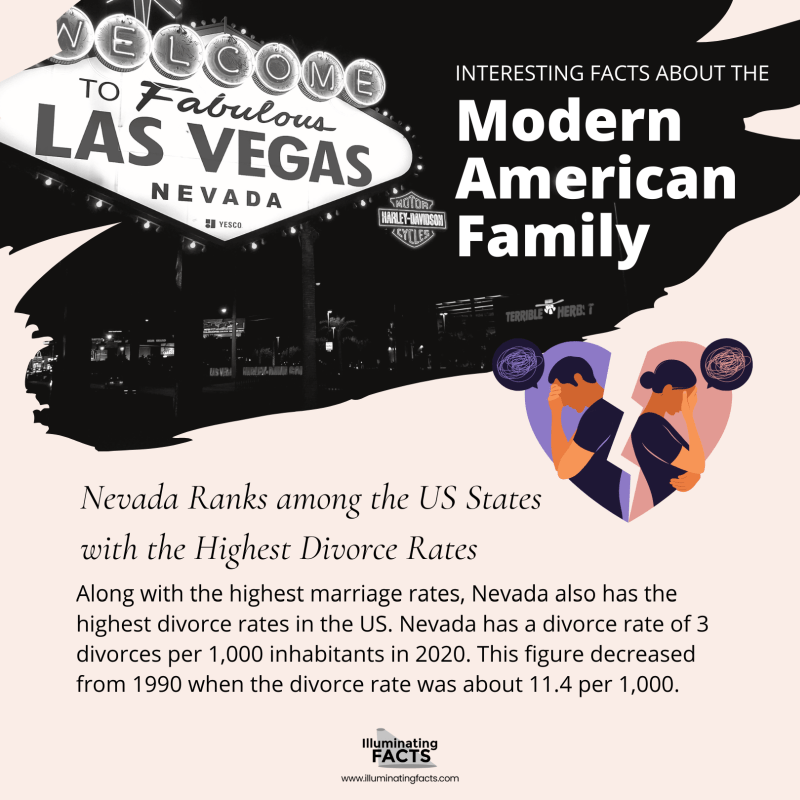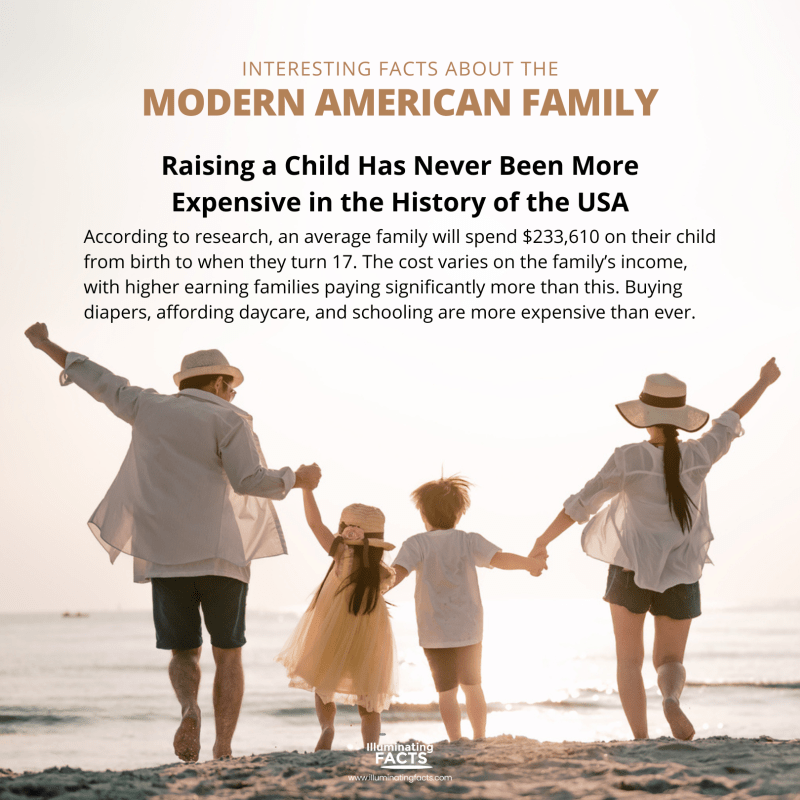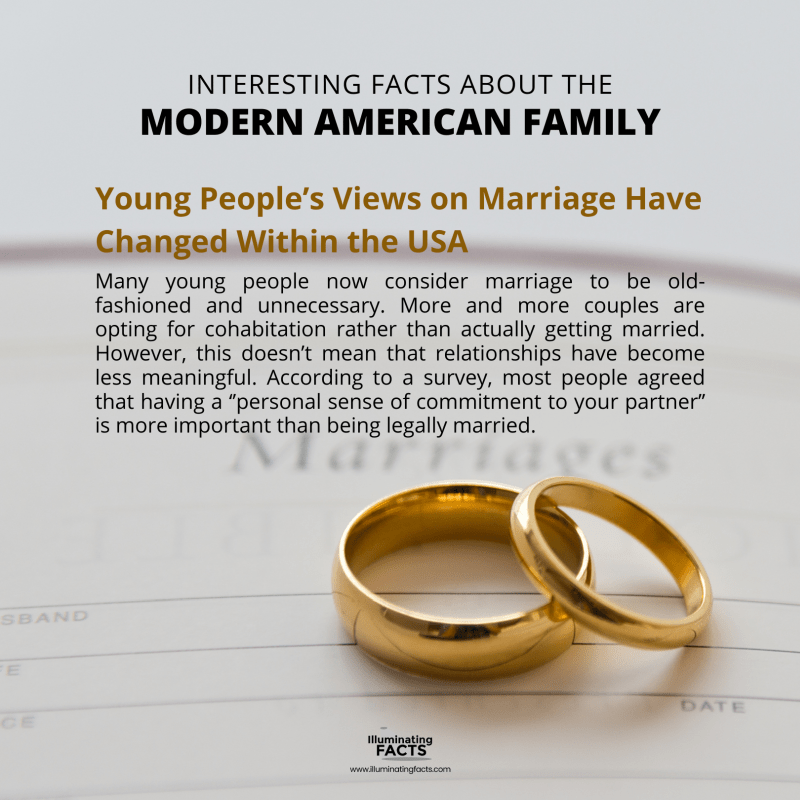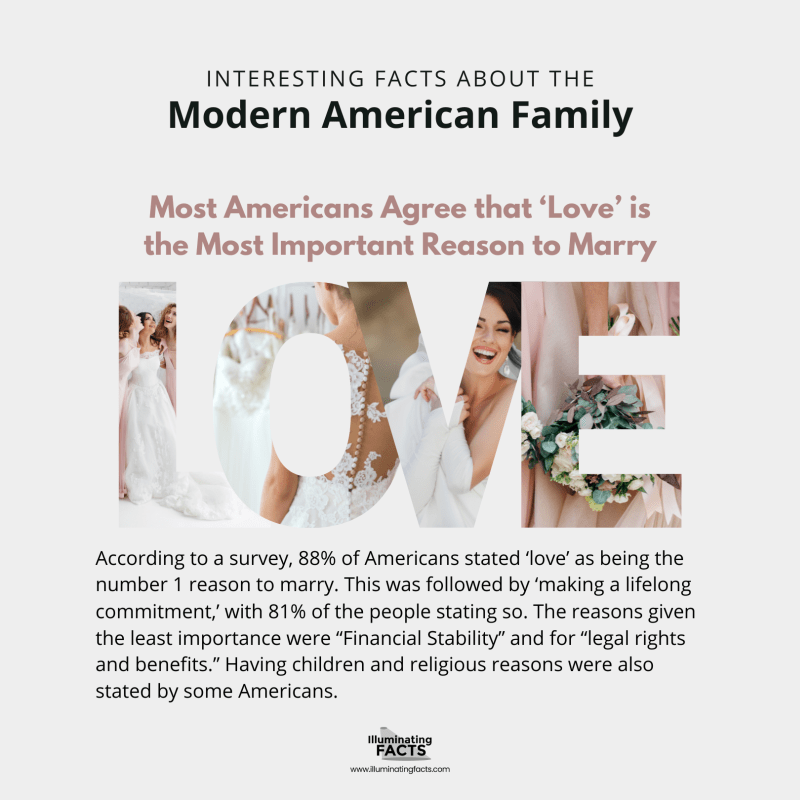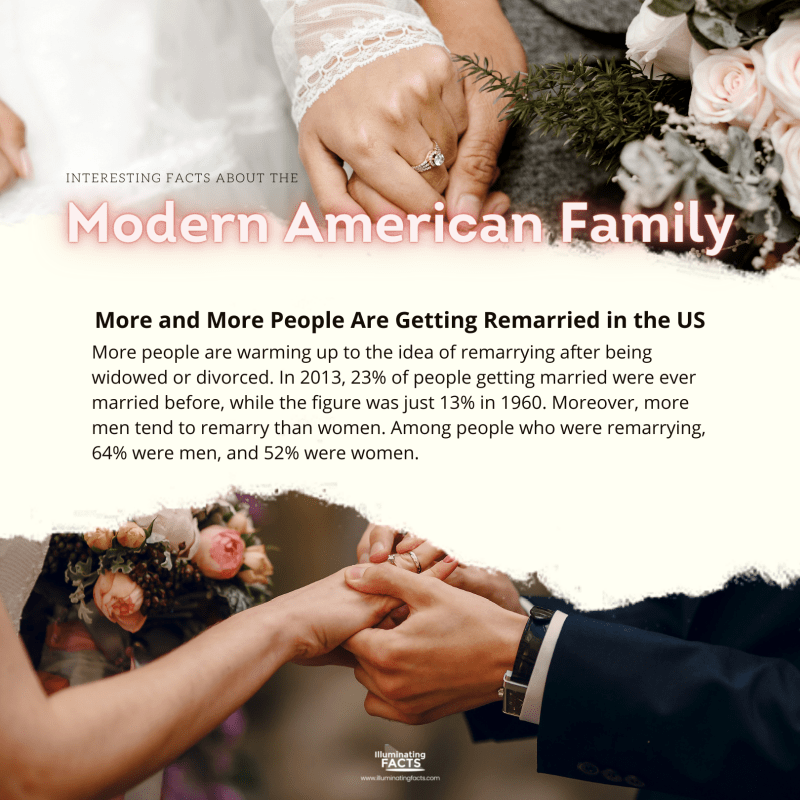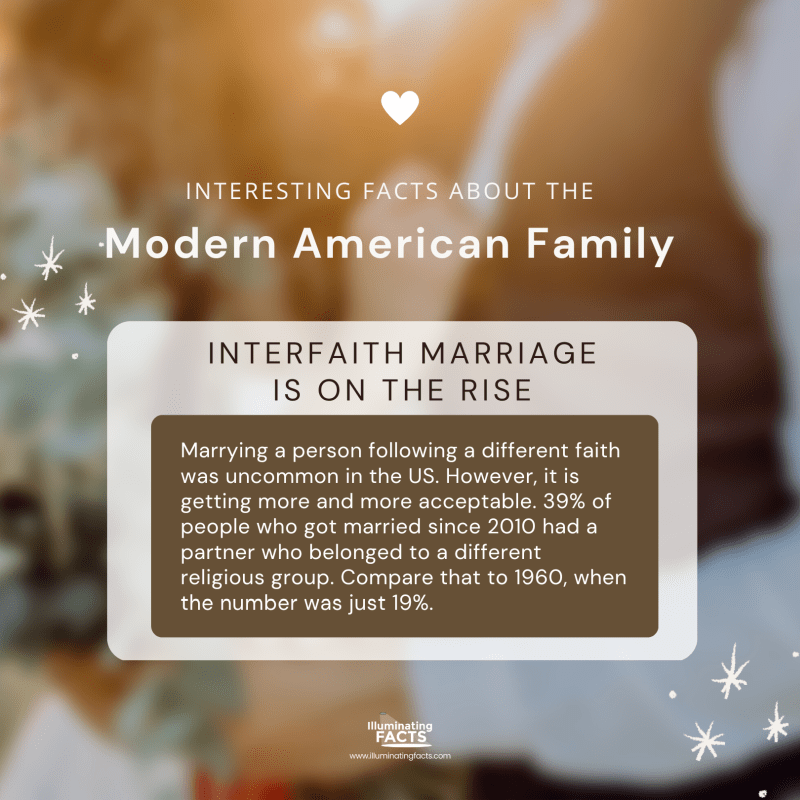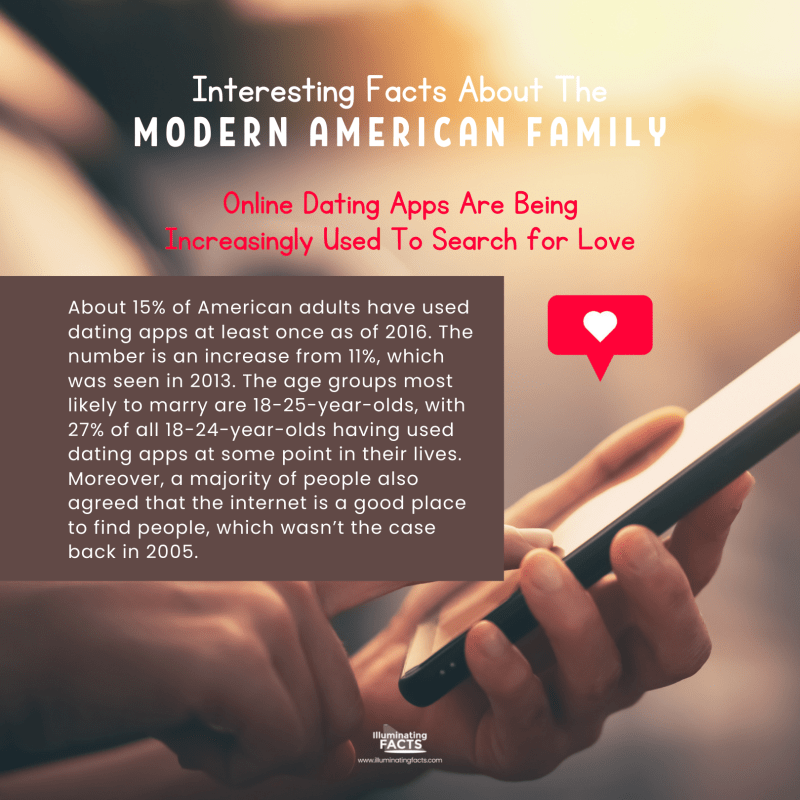The family is the basic unit of society and the foundation of any good community. The definition of ‘family’ in contemporary American society is undergoing a crucial change process. The modern family theory was shaped by historical, political, economic, and social events. A successful conclusion to these processes formed the present order of things in American family life.
Today’s American family system is not only very diverse in its traditions and customs, but it has had a profound impact on modern culture.
1. The Majority of Households in the USA, About 62%, Consist of Two Biological Parents Living With Their Children
Though the social norms are changing rapidly in the USA, 62% of the families still consist of 2 biological parents. Most of these parents are also married. Even though the ‘traditional’ family structure is prevalent, it is still declining.
This figure is a significant drop from 1960 when 85.3% of children lived with their two biological parents. [1]
2. The Marriage Rate in the US Dropped Significantly Over the Recent Years
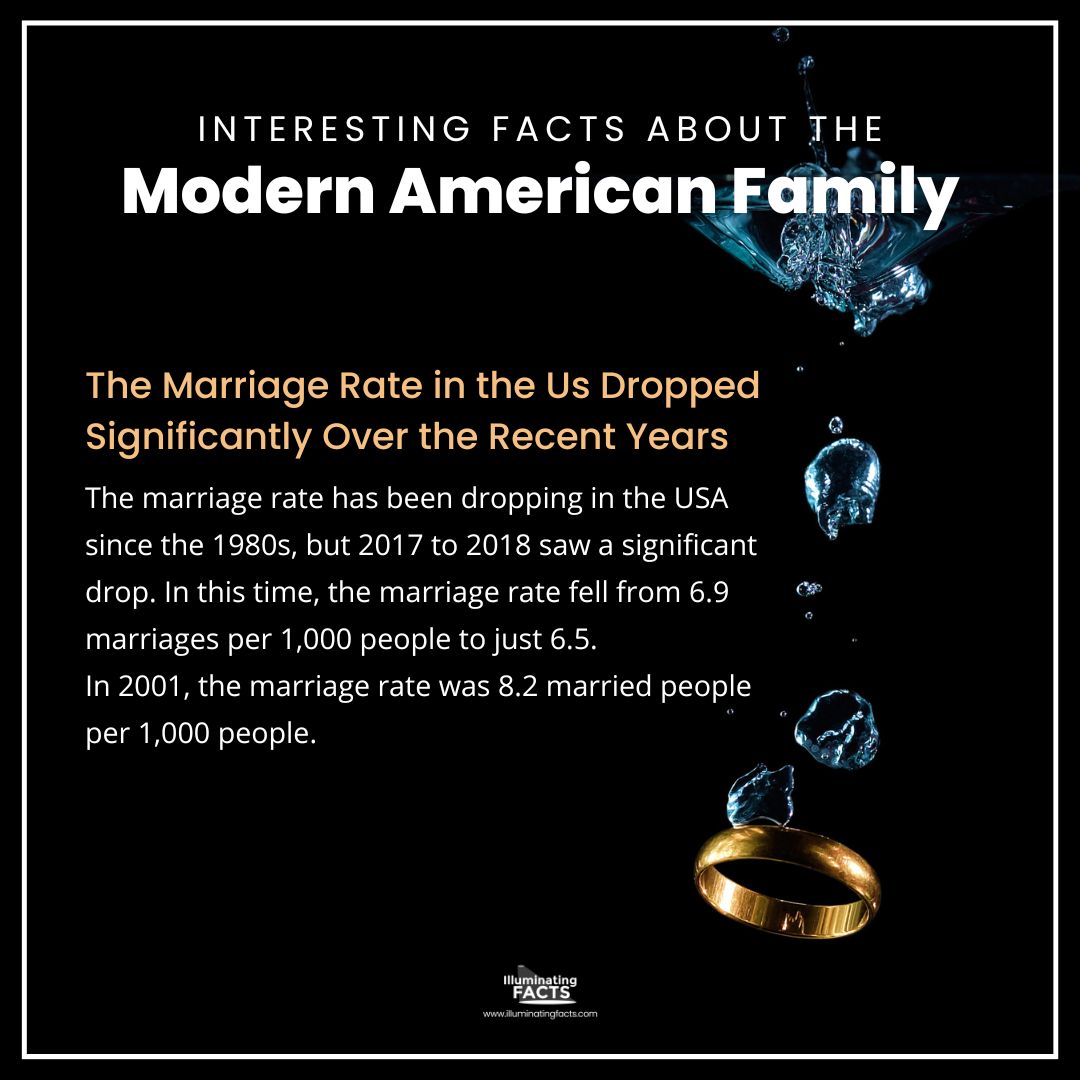
The marriage rate has been dropping in the USA since the 1980s, but 2017 to 2018 saw a significant drop. In this time, the marriage rate fell from 6.9 marriages per 1,000 people to just 6.5.
In 2001, the marriage rate was 8.2 married people per 1,000 people. [2]
3. In Nevada, You Can Get a Marriage License and Get Married on the Same Day
Nevada is one of the first few states in the USA that made getting married possible immediately after receiving the license.
Compare that to Texas and Louisiana, where you have to wait at least 72 hours before you can get married after getting a marriage license, the highest waiting period among all states. In New York and Illinois, you’ll need to wait a day at least. [3]
4. About 44% of People Aged 18-25 Live With a Stepsibling
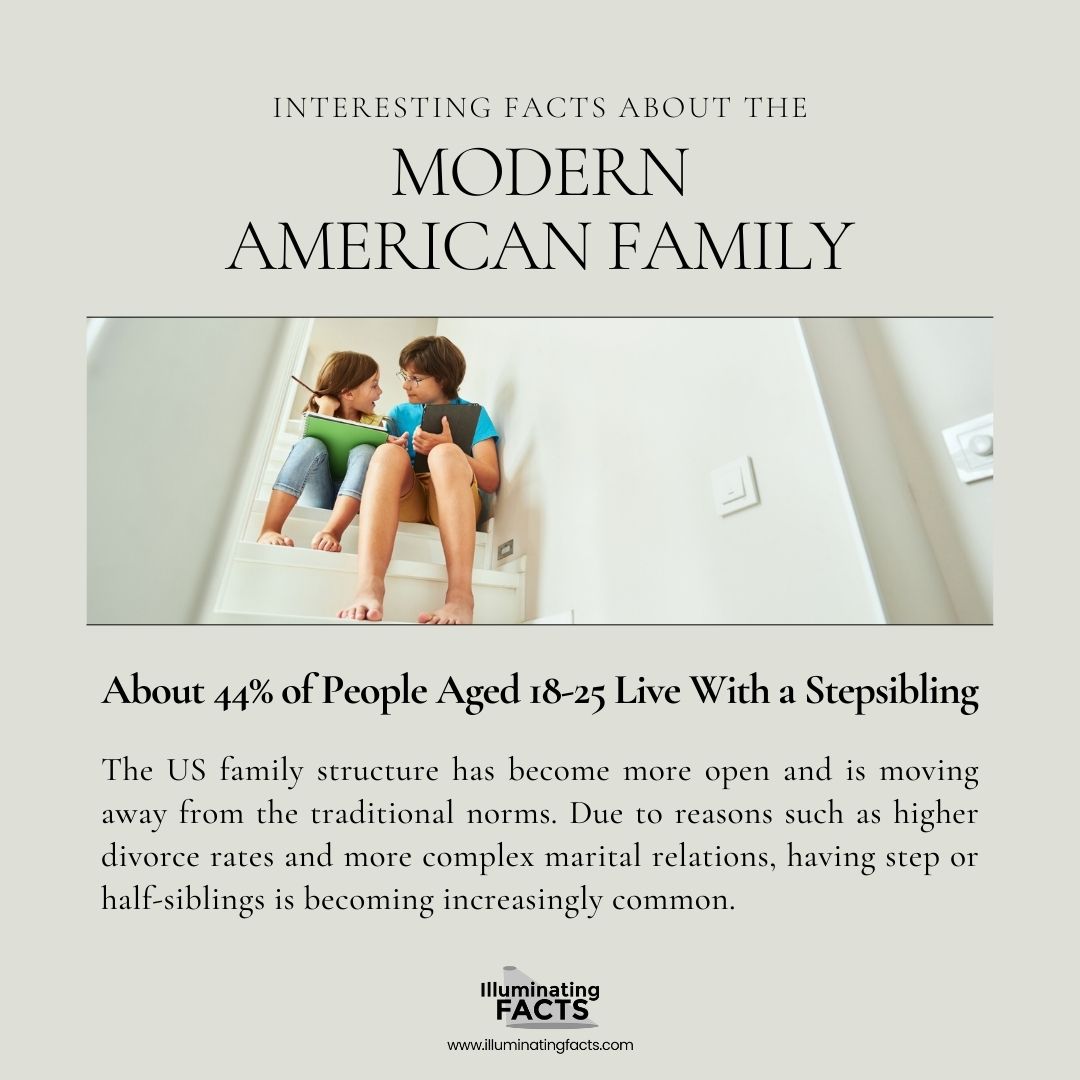
The US family structure has become more open and is moving away from the traditional norms. Due to reasons such as higher divorce rates and more complex marital relations, having step or half-siblings is becoming increasingly common.
Families having step or half-siblings have risen rapidly. In 2009, only 14% of children were living with at least one adopted, half-, or stepsibling. Now the number has risen to 44%, and that, too, excluding adopted children. [4]
5. The Number of Gay and Lesbian Couples Raising Children Has Also Increased
Gay and lesbian couple adoption was legalized in all 50 states not so long ago in 2017. Ever since the number of adoption rates has increased.
In 2016, the total number of same-sex couples raising children was 114,000. Facts also conclude that same-sex couples are 7 times more likely to raise adopted or foster kids than different-sex couples. [5]
6. The Number of Same-Sex Households Grew Much More in Some States than In Others
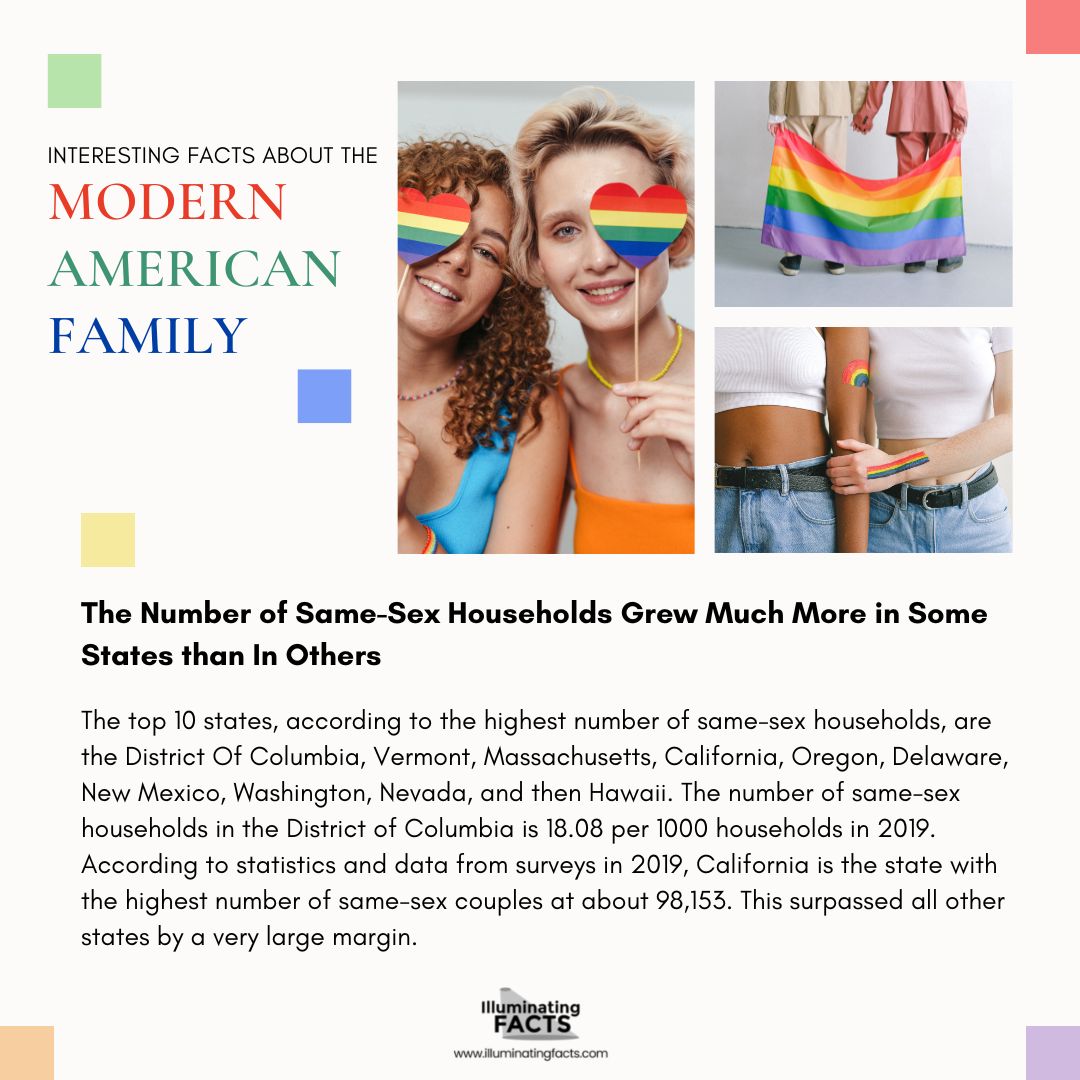
The top 10 states, according to the highest number of same-sex households, are the District Of Columbia, Vermont, Massachusetts, California, Oregon, Delaware, New Mexico, Washington, Nevada, and then Hawaii. The number of same-sex households in the District of Columbia is 18.08 per 1000 households in 2019.
According to statistics and data from surveys in 2019, California is the state with the highest number of same-sex couples at about 98,153. This surpassed all other states by a very large margin. [6]
7. 41% of All Births in the US Were to Unmarried Women In 2011
Breaking away from societal norms and decreasing religiosity in the US has caused the number of unmarried women giving birth to rise. Statistics show a gradual decrease in the percentage of birth to married women throughout the years.
However, 2011 showed a very high percentage of 40.7, with the figure decreasing to 39.8 % in 2017 and then rising again to 40% in 2019.
In 1980, only 18% of all births were accounted to unmarried women. [7]
8. Intermarriage has Become More Popular in the USA
Ethnic diversity in the US is on the rise as more and more people go to marry a person outside of their race.
In 1967, only 3% of couples belonged to different races, while the number rose to 17% in 2015. Surprisingly, interracial marriages were completely legalized in the US as early as 1967; before that, in many states, it was illegal.
Asians are the most likely to intermarry, and they account for about 29% of all intermarriages in the US. Asians are followed by Hispanics at 27%, while black people account for 18% of intermarriages. [8]
9. The US Has Seen a Steep Decrease in Fertility Rates in Women
The fertility rate of a country is the average total number of children a woman is likely to have in a certain country. In the USA, fertility rates have been seeing a gradual decrease over the recent years. In 1965, the average fertility rate was 2.913. This dropped significantly in 2019, averaging around 1.705.
The causes for this dropping trend include a change in the traditional family structure and a rise in the average age for marriages. Starting a family has also been getting increasingly expensive in the US, as well as buying a house and paying rent. All these factors result in people putting off starting a family until much later in life. [9]
10. In 2019, There Were 62 Million Married Couples in the US
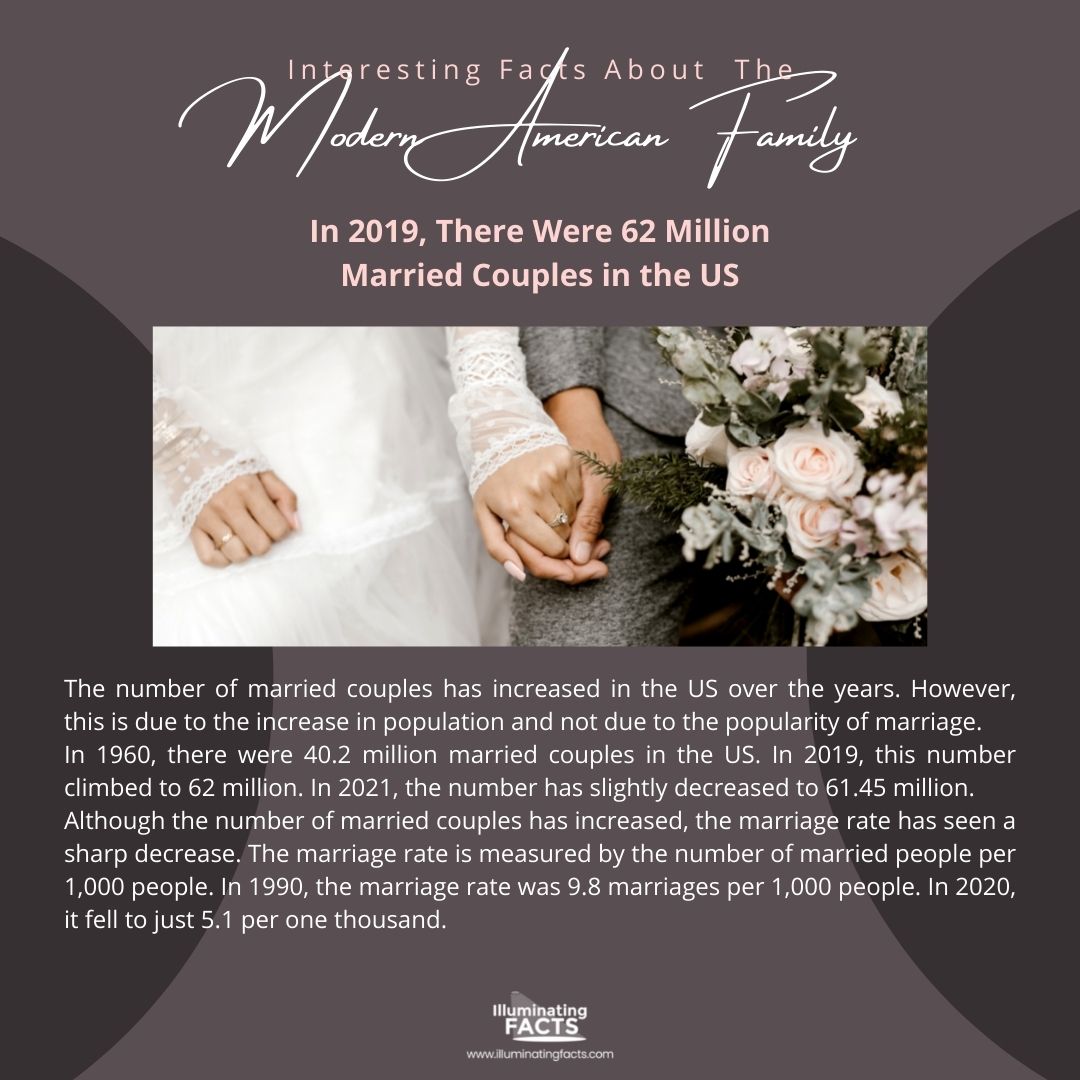
The number of married couples has increased in the US over the years. However, this is due to the increase in population and not due to the popularity of marriage.
In 1960, there were 40.2 million married couples in the US. In 2019, this number climbed to 62 million. In 2021, the number has slightly decreased to 61.45 million. [10]
Although the number of married couples has increased, the marriage rate has seen a sharp decrease. The marriage rate is measured by the number of married people per 1,000 people. In 1990, the marriage rate was 9.8 marriages per 1,000 people. In 2020, it fell to just 5.1 per one thousand. [21]
11. Nevada Has the Highest Number of Married Couples in the US

Nevada has the highest number of married couples, with 21 marriages per 1,000 people in 2020. There is a large difference between the marriage rate in Nevada and Texas. Texas has the lowest marriage rate in all of the USA, with only 5.3 marriages per 1,000 people in 2020. Economic prosperity, the mean age of the state and other demographics contribute to the difference in marriage rates per state. Marriage laws also vary with states, which further accounts for the variation in marriage rates among states. [11]
12. Nevada Ranks among the US States with the Highest Divorce Rates
Along with the highest marriage rates, Nevada also has the highest divorce rates in the US. This state has a divorce rate of 3 divorces per 1,000 inhabitants in 2020. This figure decreased from 1990, when the divorce rate was about 11.4 per 1,000. [12]
Reno, a city in Nevada, was once called the ‘Divorce capital of the world.’ The high divorce rates are said to be caused by alcohol, gambling, brothels, and dancers, which are all common in the area. The high rates can also be due to the stressful city life. [22]
13. Many Young People Are Deciding Not to Get Married In the US

Many young people are now considering putting off marriage. This is partly due to changing thoughts and behaviors where many consider marriage as old-fashioned or out of date.
Other important reasons include extensive student loans and extremely high cost of living. From 2005 to 2015, homeownership among young Americans dropped from 43.3 % to 34.6%. Inability to afford a home has a major part in lowering birth rates and marriage rates in the US. [13]
14. Raising a Child Has Never Been More Expensive in the History of the USA
According to research, an average family will spend $233,610 on their child from birth to when they turn 17. The cost varies on the family’s income, with higher earning families paying significantly more than this. Buying diapers, affording daycare, and schooling are more expensive than ever. [14]
15. Young People’s Views on Marriage Have Changed Within the USA
Many young people now consider marriage to be old-fashioned and unnecessary. More and more couples are opting for cohabitation rather than actually getting married.
However, this doesn’t mean that relationships have become less meaningful. According to a survey, most people agreed that having a ‘’personal sense of commitment to your partner’’ is more important than being legally married. [15]
16. Most Americans Agree that ‘Love’ is the Most Important Reason to Marry
According to a survey, 88% of Americans stated ‘love’ as being the number 1 reason to marry. This was followed by ‘making a lifelong commitment,’ with 81% of the people stating so.
The reasons given the least importance were “Financial Stability” and for “legal rights and benefits.” Having children and religious reasons were also stated by some Americans. [16]
17. Many Americans View Men as Financial Providers
Even though women’s economic contributions continue to grow in the US, men are still expected to provide for the family more than women.
According to a survey in 2017, about 71% of people agreed that men providing for the family is very important. As for women, only 32% stated that it is important for them to provide financially.
Women having an increasing role in the workforce has raised the economic status of many households with married couples. [17]
18. More and More People Are Getting For Remarried in the US
More people are warming up to the idea of remarrying after being widowed or divorced. In 2013, 23% of people getting married were ever married before, while the figure was just 13% in 1960.
Moreover, more men tend to remarry than women. Among people who were remarrying, 64% were men, and 52% were women. [18]
19. Interfaith Marriage Is On the Rise
Marrying a person following a different faith used to be uncommon in the US. However, this practice is getting more and more acceptable. 39% of people who got married since 2010 had a partner who belonged to a different religious group. Compare that to 1960, when the number was just 19%.
Some religious groups in the US, such as Jews, Protestants, and religiously unaffiliated people, are more likely to marry outside of their faiths than Muslims, Hindus, and Mormons. [19]
20. Online Dating Apps Are Being Increasingly Used To Search for Love
About 15% of American adults have used dating apps at least once as of 2016. The number is an increase from 11%, which was seen in 2013. The age groups most likely to marry are 18-25-year-olds, with 27% of all 18-24-year-olds having used dating apps at some point in their lives.
Moreover, a majority of people also agreed that the internet is a good place to find people, which wasn’t the case back in 2005. [20]
Conclusion
The number of traditional two-parent family households has steadily declined since the 1940s. This decline is most pronounced among young people, with adults under 29 being the only age demographic to show a decline in the percentage of traditional families; otherwise, adults of all other ages are more likely than not to live in single-parent or unmarried-partner households.
Throughout their formative years, American children today have also spent less time living in a traditional, married family household than any previous generation since survey data began to be collected. Although more research is needed on how these changes impact children and their development, it is clear that there have been significant shifts in the ways American adults raise their children and connect with each other.
References
- Hemez, P., & Washington, C. (2021, April 12). Number of children living only with their mothers has doubled in past 50 years. The United States Census Bureau. https://www.census.gov/library/stories/2021/04/number-of-children-living-only-with-their-mothers-has-doubled-in-past-50-years.html
- U.S. Marriage Rates Hit New Recorded Low – U.S. Marriage Rates Hit New Recorded Low – United States Joint Economic Committee. (n.d.). Www.jec.senate.gov. https://www.jec.senate.gov/public/index.cfm/republicans/2020/4/marriage-rate-blog-test
- Nolo. (2011, October 10). Chart: State Marriage License and Blood Test Requirements. Www.nolo.com; Nolo. https://www.nolo.com/legal-encyclopedia/chart-state-marriage-license-blood-29019.html
- Aldrich, L., Nomaguchi, K., Amy, A., Graduate, M., Representative, F., Guzzo, K., Lin, I-Fen., & Manning, W. (2021). THE ASSOCIATION BETWEEN SIBLING TYPE, SIBLING RELATIONSHIP QUALITY, AND MENTAL HEALTH FROM ADOLESCENCE INTO YOUNG ADULTHOOD. https://etd.ohiolink.edu/apexprod/rws_etd/send_file/send?accession=bgsu1617280384983733&disposition=inline
- thisisloyal.com, L. |. (2018, July). How Many Same-Sex Couples in the US are Raising Children? Williams Institute. https://williamsinstitute.law.ucla.edu/publications/same-sex-parents-us/
- The Williams Institute. (2019). Ucla.edu. https://williamsinstitute.law.ucla.edu/visualization/lgbt-stats/?topic=SS&compare=total#comparison
- Births to unmarried women U.S. percentage 1980-2020. (n.d.). Statista. https://www.statista.com/statistics/276025/us-percentage-of-births-to-unmarried-women/
- NW, 1615 L. S., Suite 800Washington, & Inquiries, D. 20036USA202-419-4300 | M.-8.-8. | F.-4.-4. | M. (2017, May 18). Intermarriage in the U.S. 50 Years After Loving v. Virginia. Pew Research Center’s Social & Demographic Trends Project. https://www.pewresearch.org/social-trends/2017/05/18/intermarriage-in-the-u-s-50-years-after-loving-v-virginia/
- Fertility rate, total (births per woman) | Data. (2017). Worldbank.org. https://data.worldbank.org/indicator/SP.DYN.TFRT.IN?locations=US
- Number of married couples in the U.S. 1960-2018 | Statista. (2018). Statista; Statista. https://www.statista.com/statistics/183663/number-of-married-couples-in-the-us/
- Marriage rates, by state U.S. 2020. (n.d.). Statista. Retrieved October 19, 2022, from https://www.statista.com/statistics/227305/highest-marriage-rates-by-us-state
- Divorce rate in Nevada 2020. (n.d.). Statista. Retrieved October 19, 2022, from https://www.statista.com/statistics/207208/divorce-rate-in-nevada/
- Holland, K. (2015, June 15). The high economic and social costs of student loan debt. CNBC; CNBC. https://www.cnbc.com/2015/06/15/the-high-economic-and-social-costs-of-student-loan-debt.html
- Bhattarai, A. (n.d.). It’s more expensive than ever to raise a child in the U.S. Washington Post. https://www.washingtonpost.com/news/business/wp/2017/01/10/its-more-expensive-than-ever-to-raise-a-child-in-the-u-s/
- Collins, L. M. (2021, October 12). Are young people kissing marriage goodbye? Deseret News. https://www.deseret.com/2021/10/12/22696492/young-adults-attitude-toward-marriage-is-changing-why-thats-important-american-family-survey
- Geiger, A., & Livingston, G. (2019, February 13). 8 facts about love and marriage in America. Pew Research Center; Pew Research Center. https://www.pewresearch.org/fact-tank/2019/02/13/8-facts-about-love-and-marriage/
- NW, 1615 L. S., Suite 800Washington, & Inquiries, D. 20036USA202-419-4300 | M.-8.-8. | F.-4.-4. | M. (2017, September 20). Men seen as financial providers in U.S., even as women’s contributions grow. Pew Research Center. https://www.pewresearch.org/fact-tank/2017/09/20/americans-see-men-as-the-financial-providers-even-as-womens-contributions-grow/
- Growing Number of Americans Have Remarried. (2014, November 14). Pew Research Center’s Social & Demographic Trends Project. https://www.pewresearch.org/social-trends/2014/11/14/four-in-ten-couples-are-saying-i-do-again/
- Caryle Murphy. (2015, June 2). Interfaith marriage is common in U.S., particularly among the recently wed. Pew Research Center; Pew Research Center. https://www.pewresearch.org/fact-tank/2015/06/02/interfaith-marriage/
- Smith, A., & Maeve Duggan. (2013, October 21). Online Dating & Relationships. Pew Research Center: Internet, Science & Tech; Pew Research Center: Internet, Science & Tech. https://www.pewresearch.org/internet/2013/10/21/online-dating-relationships/
- USA – Marriage rate 1990-2017 | Statista. (2017). Statista; Statista. https://www.statista.com/statistics/195951/marriage-rate-in-the-united-states-since-1990/
- Reno Divorce History. (n.d.). Reno Divorce History. Retrieved October 19, 2022, from https://renodivorcehistory.org/


